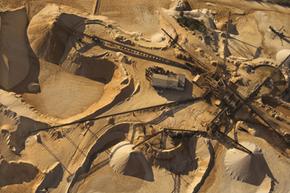In movies about archaeology and paleontology, you don't see much about fundraising time tables. Indiana Jones may have a ticking clock because he's in a race against the Nazis, but he's not working on the schedule that his funding dictates. In fact, Dr. Jones never seems to worry about the budget at all. Real life archaeologists dream about scenarios like this, but unfortunately they're met with strict deadlines that are usually set according to funding.
How long it takes to excavate an archaeological dig site all depends on how much cash a dig team has to get the job done. If it were up to the diggers, they'd probably never put the shovel down, but, like everything else, science costs money. In fact, to even begin most archaeological excavations, funding has to be in place. And the amount of money the project has in place typically determines the length of the dig, in most cases. Ideally, the budget will allow the dig team enough time to unearth everything they're looking for, but rarely are digs about finding one single item, like in the movies. Generally, a site is chosen based on the likelihood that a multitude of items could be unearthed during the course of the dig. However, in some cases a single item is the goal. In those cases, a dig may continue until that item is found, provided that funding doesn't dry up.
Advertisement
Here's how a dig generally works: A site is found, and an eager archeologist wants to get her hands dirty. Depending on whether she works for a museum, a university or is a freelancer, there are a few ways she can go about securing funding. Universities and museums will likely have some kind of budget already, or they may have an ongoing grant that provides funds each year. For instance, the University of Pittsburgh has an ongoing grant from the Heinz Grant Program for Latin American Archaeology that awards 10 grants per year of $8,000. So, let's say you work as a researcher at Pitt. You can apply for one of those grants through the university and then pick a site that interests you that will work within that budget. Maybe there's a Native American site nearby in Pennsylvania that would allow for a two-month dig. Or perhaps Egypt is calling your name, but you can only go for a week with the same amount of funding.
If a government body or a museum with deep pockets is behind the funding, you may be able to dig for as long as you need. But one thing's for sure, starting a site from scratch takes a lot longer than working on a site that's already been excavated. Excavation isn't as simple as bringing in the heavy machinery and plowing earth at double speed. It's a painstaking process of removing one level of earth at a time. How deep objects are found helps archeologists determine how old an item is.
Organizing and staffing a new dig is a large undertaking. Equipment and staff are brought in, put up somewhere (sometimes on site in tents), and the general area is cleared of all grass and foliage when necessary. Then the archaeologists will devise a plan for the site, map out the dig area, and the work begins. Once the dig starts, it's a slow and deliberate process to protect the area and any items workers come across. The team carefully sifts through every bucket of dirt to find the prized artifacts, and items are logged and sometimes photographed in place before removal. This can be painstakingly slow, so even a small site can take a full week or more to excavate. If it's a newsworthy site, it's likely someone will have to deal with local and perhaps national and international press, as well, which can drag out the excavation process.
For sites that are vast and protected by the government, then the dig may go on as long as funding allows. For example, at the Presidio in San Francisco, the site of an 18th century Spanish fort is set up for an ongoing year-round excavation, with the help of a volunteer program through the National Park Service. Several other sites have gone to a similar volunteer-based model after the main excavation has ended. The Crow Canyon Archaeological Center in Cortez, Colo., continues to allow visitors to assist in a dig that was officially wrapped up in 2007. So ultimately, it's not as much about how long it takes to excavate a site, but how long finances allow it.
Advertisement
